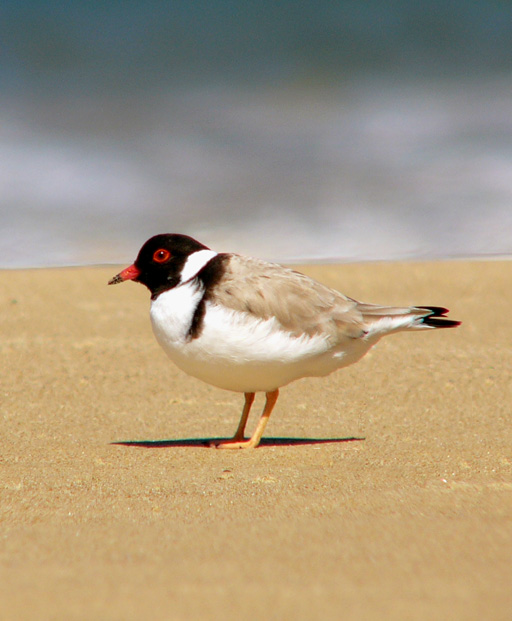| Line 1: | Line 1: | ||
;Charadrius rubricollis | ;Charadrius rubricollis | ||
| − | [[Image:Hooded_Plover.jpg|thumb| | + | [[Image:Hooded_Plover.jpg|thumb|550px|right|Photo by FelixWilson]] |
| − | |||
| − | |||
==Identification:== | ==Identification:== | ||
| − | The adults are only 7.5-9 in (19-23 cm) long. Adults have a distinctive red bill with a black tip. Red eye ring. Black head; white collar. Back pale grey-brown. Lower neck, side of breast black. Broad white wing bar in flight. | + | Photographed in Tasmania. |
| − | + | ||
| − | + | The adults are only 7.5-9 in (19-23 cm) long. Adults have a distinctive red bill with a black tip. Red eye ring. Black head; white collar. Back pale grey-brown. Lower neck, side of breast black. Broad white wing bar in flight. | |
| − | + | ==Distribution= | |
| − | |||
| − | |||
Endemic to Australia. | Endemic to Australia. | ||
| − | == | + | ==Taxonomy== |
| − | + | ==Habitat== | |
| + | Ocean beaches and on coastal and inland salt lakes. | ||
| + | ==Behaviour== | ||
| + | The Hooded Plover nests on the beach between the high tide water mark and the fore dune. The nest comprises a shallow scrape in the sand. Two or three eggs are laid and incubated for 27-31 days. In Western Australia breeding can potentially occur through out the year. They take approximately four weeks to hatch and are flightless for five to six weeks after that. The eggs and flightless chicks can easily be hunted and eaten by foxes, dogs and cats. Being highly camouflaged they are also accidentally crushed by pedestrians, four-wheel drive vehicles and trail bikes. | ||
==External Links== | ==External Links== | ||
*[http://www.birdforum.net/pp_gallery/showgallery.php?mcats=all&si=Thinornis%20rubricollis&what=allfields&name=&when=&whenterm= View more images of Hooded Plover in the gallery] | *[http://www.birdforum.net/pp_gallery/showgallery.php?mcats=all&si=Thinornis%20rubricollis&what=allfields&name=&when=&whenterm= View more images of Hooded Plover in the gallery] | ||
*[http://www.aviceda.org/abid/birdimages.php?action=birdspecies&fid=39&bid=508 View more images of this species on the ABID] | *[http://www.aviceda.org/abid/birdimages.php?action=birdspecies&fid=39&bid=508 View more images of this species on the ABID] | ||
[[Category:Birds]] | [[Category:Birds]] | ||
Revision as of 16:02, 9 June 2007
- Charadrius rubricollis
Identification:
Photographed in Tasmania.
The adults are only 7.5-9 in (19-23 cm) long. Adults have a distinctive red bill with a black tip. Red eye ring. Black head; white collar. Back pale grey-brown. Lower neck, side of breast black. Broad white wing bar in flight.
=Distribution
Endemic to Australia.
Taxonomy
Habitat
Ocean beaches and on coastal and inland salt lakes.
Behaviour
The Hooded Plover nests on the beach between the high tide water mark and the fore dune. The nest comprises a shallow scrape in the sand. Two or three eggs are laid and incubated for 27-31 days. In Western Australia breeding can potentially occur through out the year. They take approximately four weeks to hatch and are flightless for five to six weeks after that. The eggs and flightless chicks can easily be hunted and eaten by foxes, dogs and cats. Being highly camouflaged they are also accidentally crushed by pedestrians, four-wheel drive vehicles and trail bikes.




